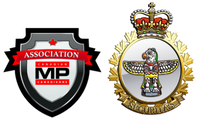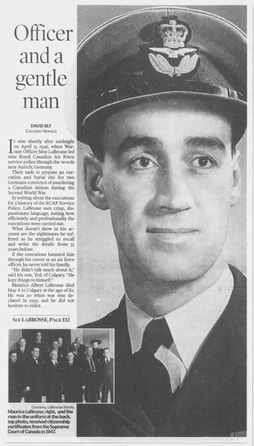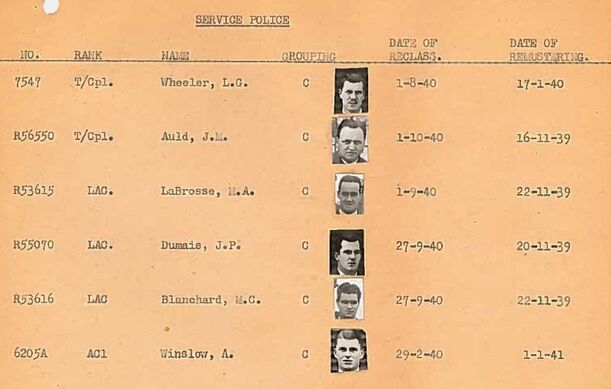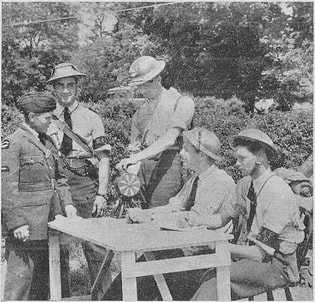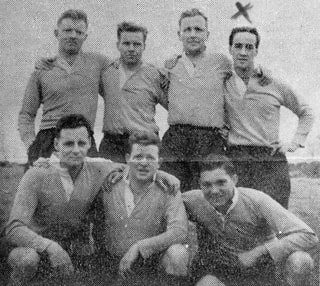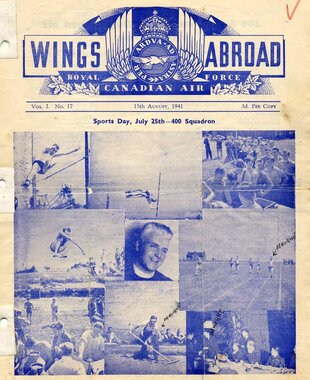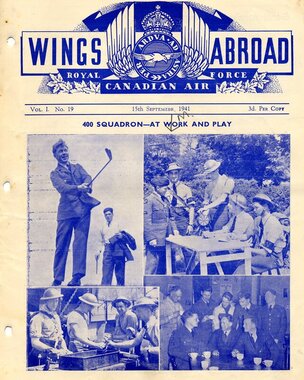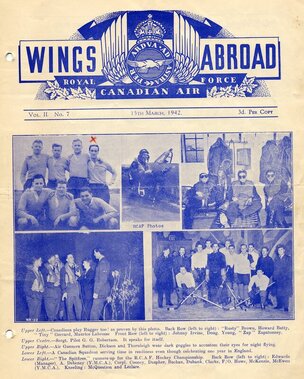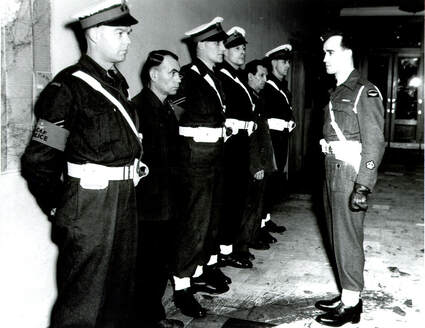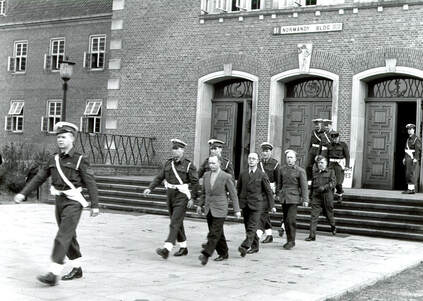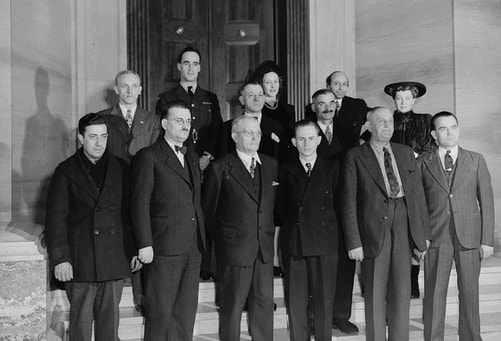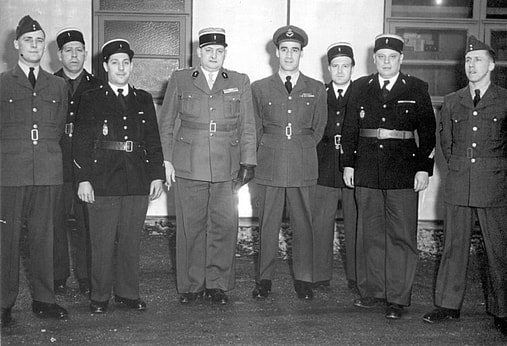Looking Back: Wartime RCAF Policemen and Post-war
Security Officer Moe LaBrosse
By Lieutenant-Colonel Paul Thobo-Carlsen (Retired), CMPA Director of History & Heritage.
|
The 30-year military career of Squadron Leader Maurice Albert (Moe) LaBrosse, CD—which spanned the Second World War and two and half decades into the Cold War—was extraordinary by any standard and included a number of firsts and unique assignments.
Hailing from the nation capital region, Moe studied at the University of Ottawa before enlisting in the RCAF in November 1939 just two months after Canada entered the war against Nazi Germany. He graduated from one of the first RCAF Service Police (SP) courses held at No. 1 Manning Depot in Toronto (at the old Exhibition Grounds) and was posted to RCAF Station Rockciffe for a very short time before deploying overseas as part of the inaugural 4-man SP section with No. 110 (Army Co-operation) Squadron.
On 25 February 1940, Aircraftman Labrosse made history as the very first member of the RCAF to step foot on overseas soil during the Second World War. After arriving in England on the Duchess of Bedford, he explained, "I was on duty when the boat docked and that entailed me going down the gangplank before a battery of cine cameras, flash bulbs and waiting newspapermen. A General came along and said 'come with me.' I replied 'I'm sorry sir, I'm on duty.' The General said, 'Never mind that, I'm a General, come with me.' So I had to go along with him and speak a few words into the microphone for a broadcast of our arrival while cameras ground away and flash bulbs went off."[1]
|
|
Under the supervision of Corporal Lawrence Wheeler, Labrosse and fellow Leading Aircraftsmen John Auld and Pierre Dumais established the first overseas RCAF Service Police detachment in support of No. 110 Squadron (re-designated 400 Squadron in 1941). From 1940 to 1943, this unit was based in England and provided direct support to the 1st Canadian Division in preparing and training for a potential invasion of the United Kingdom. It also provided support to Royal Air Force Fighter Command and the RCAF’s No. 1 Fighter Squadron once the Battle of Britain broke out.[2]
|
|
During his time with 400 Squadron, Labrosse frequently demonstrated his athletic prowess during inter-unit sporting events. In addition to being a member of the Squadron rugby and softball teams, his podium finishes during inter-unit sports meets were mentioned in several editions of the unit newspaper (Wings Abroad). In particular, Moe excelled in the throwing events such as the javelin and shot-put.
|
A number of Wings Abroad newspapers, previously belonging to LaBrosse himself, are featured in the RCAF 403 Squadron online blog. Several of them are reprinted below (click on each to view the full-size image).[3]
While serving at RAF Station Odiham with 400 Squadron, Moe met his future wife Nichola, who hailed from Aberdeenshire, Scotland. They were married in January 1942. Around the same period he was involved in the capture of two German airmen who bailed out of their damaged aircraft over Hampshire. In September 1942, LaBrosse was posted to RCAF "R" Depot in Warrington (the repatriation center for airmen returning to Canada) to become the first service policeman at this unit. He was also the last to leave the depot when it moved to a new location in May 1945.[5]
|
Following the cessation hostilities that same month, the RCAF became involved in the investigation of war crimes committed against RCAF personnel by members of the wartime German regime. This culminated in a series of war crime trails held in 1946 in Aurich, Germany. By then a Warrant Officer 2nd Class, Moe LaBrosse was posted there as second-in-command of the supporting Service Police detail. During the war crime trails his duties included supervising the guarding and escort of prisoners, searching of witnesses and German spectators at the trial, and general courtroom security. In a public relations interview at the time, LaBrosse stated, "We have to watch the prisoners very carefully and several inspections a day are made in their cells and even of their persons. They wear special clothing and are watched every minute while eating their meals and, while each of them has a 20-minute exercise period a day, these are given them separately and under heavy guard."[6]
|
|
|
After several death sentences were handed down by the court, WO2 Labrosse was tasked to take on a far more odious role as the officer-in-charge of the firing squads. Shortly after the confirmation of the first two sentences, a decision was made that RCAF Service Police would be solely responsible for carrying out the executions. In all, four executions were carried out in April and May 1946. This was the first and only time RCAF Police would find themselves having to fulfill this unpleasant duty. Ironically, one of those sentenced to death was a German Military Policeman by the name of Robert Hotzer who was found guilty of murdering a wounded RCAF airman in 1945.[7]
In a tribute article published in the Calgary Herald shortly after Moe's death in May 2002, it was revealed that he had suffered nightmares as he struggled to recall the details of his involvement in these executions for a written history of the RCAF Service Police. His son Ted noted that, "He didn't talk much about it. He kept things to himself."[8] Clearly, this was a distasteful chapter in Moe's military career even though his subsequent written summary of the events (see footnote 7) noted how efficiently and professionally the executions were carried out by the RCAF Provost Officers and SP personnel involved.
|
|
Moe returned to Canada with his wife and first son Raymond after the war crime trials ended, having served overseas continually for over six years except for a 30-day leave to Canada in 1944 when his mother passed way. In order to secure a position in the drastically downsized post-war RCAF, he reverted to Sergeant rank and was then posted to the Administrative Unit at Maintenance Command Headquarters in Uplands (Ottawa).
In 1947, Moe and his wife were selected to take part in yet another first—this one being much more uplifting than the last. They were both selected to receive their Canadian citizen certificates at the very first such ceremony. Up until 1949, Canadian nationals were still considered to be British subjects. This changed on 1 January 1947 with the passage of the Canadian Citizenship Act into law. The Member of Parliament who introduced the bill, Paul Martin Sr., stated that ”For the national unity of Canada and for the future and greatness of this country it is felt to be of utmost importance that all of us, new Canadians or old, have a consciousness of a common purpose and common interests as Canadians; that all of us are able to say with pride and say with meaning: ‘I am a Canadian citizen”.[9]
|
|
On 3 January, twenty-five hand-picked Canadians attended this ceremony at the Canadian Supreme Court in Ottawa. Prime Minister William Lyon Mackenzie-King received citizen certificate number 0001. Sergeant Maurice LaBrosse, representing French Canadians, received certificate number 0004. Nicola LeBrosse, representing war brides, received certificate number 0005. Other distinguished Canadians at the ceremony included the mother of deceased Pilot Officer Andrew Mynarski (VC) and internationally-renowned photographer Yusef Karsh.
Following the ceremony, Moe shock hands with the Prime Minister and let him know they had met before. He later explained that, "When I was a young boy, we used to live next to the prime minister's residence, which was not fenced at the time. One day I was caught on the grounds taking apples from his orchard. According to Moe, "Mackenzie King recalled it with heartfelt laughter."[11]
|
----------
Notes:
1. Flight Lieutenant E.R. Martin, RCAF Public Relations Press Release 11575, 25 March 1946 (in DHH file 79/454).
2. Major Mathias Joost, The Battle of Britain: Army Cooperation Squadrons, RCAF News article, 24 July 2015, at http://www.rcaf-arc.forces.gc.ca/en/news-template-standard.page?doc=the-battle-of-britain-army-cooperation-squadrons/icdjorcj; Canada, DND, A-AD-267-000/AF-004, Insignias and Lineages of the Canadian Forces, Volume 4, Flying Squadrons, 400 Tactical Helicopter Squadron, at http://www.cmp-cpm.forces.gc.ca/dhh-dhp/his/ol-lo/vol-tom-4/doc/3606.pdf, ,
3. RCAF 403 Squadron blog at https://rcaf403squadron.wordpress.com/2015/08/02/wings-abroad-volume-2-no-7-15th-march-1942/
4. Press Release 11575, 25 March 1946.
5. Ibid.
6. Ibid.
7. Additional details of the RCAF war crime trails and subsequent executions, including LaBrosse's personnel account, can be found in Colonel (Retired) R. J. Donovan and Lieutenant-Colonel (Retired) D. V. McElrea, A History of the Royal Canadian Air Force Police and Security Services, (Renfrew, ON: General Store Publishing, 2008), Chapter 8.
8. David Bly, "Officer and a Gentle Man," Calgary Herald, Sun 26 May 2002, 22 and 48.
9. Radio Canada International, History Canada: Jan 3, 1947 - The very first Canadian Citizen, By Marc Montgomery, at https://www.rcinet.ca/en/2019/01/03/history-canada-jan-3-1947-the-very-first-canadian-citizen/
10. Ibid; Bly, "Officer and a Gentle Man"; and Nanaimo Free Press, Friday, 3 January 1947, 1.
11. Bly, Officer and a Gentle Man.
Notes:
1. Flight Lieutenant E.R. Martin, RCAF Public Relations Press Release 11575, 25 March 1946 (in DHH file 79/454).
2. Major Mathias Joost, The Battle of Britain: Army Cooperation Squadrons, RCAF News article, 24 July 2015, at http://www.rcaf-arc.forces.gc.ca/en/news-template-standard.page?doc=the-battle-of-britain-army-cooperation-squadrons/icdjorcj; Canada, DND, A-AD-267-000/AF-004, Insignias and Lineages of the Canadian Forces, Volume 4, Flying Squadrons, 400 Tactical Helicopter Squadron, at http://www.cmp-cpm.forces.gc.ca/dhh-dhp/his/ol-lo/vol-tom-4/doc/3606.pdf, ,
3. RCAF 403 Squadron blog at https://rcaf403squadron.wordpress.com/2015/08/02/wings-abroad-volume-2-no-7-15th-march-1942/
4. Press Release 11575, 25 March 1946.
5. Ibid.
6. Ibid.
7. Additional details of the RCAF war crime trails and subsequent executions, including LaBrosse's personnel account, can be found in Colonel (Retired) R. J. Donovan and Lieutenant-Colonel (Retired) D. V. McElrea, A History of the Royal Canadian Air Force Police and Security Services, (Renfrew, ON: General Store Publishing, 2008), Chapter 8.
8. David Bly, "Officer and a Gentle Man," Calgary Herald, Sun 26 May 2002, 22 and 48.
9. Radio Canada International, History Canada: Jan 3, 1947 - The very first Canadian Citizen, By Marc Montgomery, at https://www.rcinet.ca/en/2019/01/03/history-canada-jan-3-1947-the-very-first-canadian-citizen/
10. Ibid; Bly, "Officer and a Gentle Man"; and Nanaimo Free Press, Friday, 3 January 1947, 1.
11. Bly, Officer and a Gentle Man.
